Today was my second day back in Haiti since the earthquake. Before leaving, I was having some pretty significant anxiety about returning. I am happy to report that since arriving in Haiti, I’ve been doing really well. There have been a few minor triggers, but for the most part I’m finding myself calm and able to be present with what we are doing at each moment. That has been a huge blessing. I was also worried that I was going to feel immediately distraught and discouraged, because I’ve heard so many stories about how little progress has been made. While it’s true that there is still a lot of work to be done, I’ve been surprised at how much has been rebuilt in the past two years. 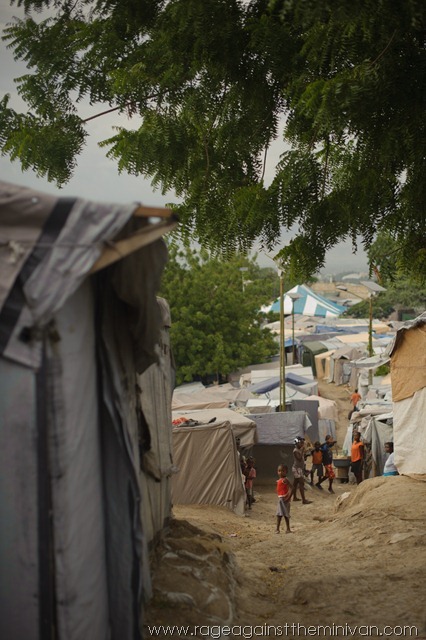 Today we visited “Tent City” – the largest tent camp community in Haiti where over 60,000 displaced people took up residency after losing their homes. I knew this would be the most difficult place to visit, and it was. It was dark and dirty and depressing, and I found myself feeling especially burdened for the young girls who live there. It is such a vulnerable place for children. The poverty alone is enough to make you want to curl up in a fetal position. But thinking about what the young girls here are up against in terms of having their childhood cut short . . . it’s difficult to fathom. A local told us that this place used to be referred to as “rape camp”. I think I am still in denial about the true horror of that reality for the young girls I exchanged handshakes with today.
Today we visited “Tent City” – the largest tent camp community in Haiti where over 60,000 displaced people took up residency after losing their homes. I knew this would be the most difficult place to visit, and it was. It was dark and dirty and depressing, and I found myself feeling especially burdened for the young girls who live there. It is such a vulnerable place for children. The poverty alone is enough to make you want to curl up in a fetal position. But thinking about what the young girls here are up against in terms of having their childhood cut short . . . it’s difficult to fathom. A local told us that this place used to be referred to as “rape camp”. I think I am still in denial about the true horror of that reality for the young girls I exchanged handshakes with today. 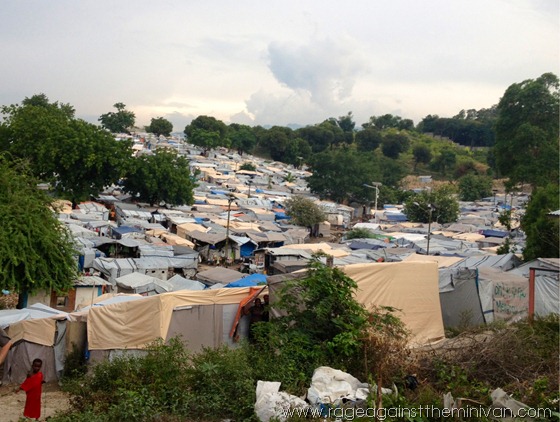 In Haiti, it always seems like there are more problems than solutions, and more questions than answers. I’ve only been here two days and we’ve already had some of these difficult conversations. Anyone who has served in Haiti for long can attest that aid in this country is something that must constantly be negotiated, and that can easily go wrong. That rice that was handed out freely after the earthquake? It robbed the rice farmer of a living. That shiny new orphanage that was built down the road? It inspired several families to abandon their children so that they could grow up living in the closest thing to Disneyland that they’ve ever seen. The aid money that you gave to a pastor to distribute to the poor? It just made him a target of resentment in his own community. Aid is a tricky thing. I am traveling with an organization called Help One Now, and one of the things I most appreciate about their leaders is that they are constantly re-evaluating what “best practice” looks like as they serve here. They work alongside Haitian leaders, consulting with them to make sure that their impact is lasting. They won’t do a project without a Haitian involved, and they strive to minimize dependence on international aid. Today we met one of their Haitian partners: Pastor St. Cyr. He has been a leader at Tent City since it began – consulting with everyone from Sean Peen to CNN on how to best serve the people now living on this former golf course. Today, under 20,000 people reside in Tent City. Many people have been able to leave and find a permanent home . . . but about 1/3 of the people remain. Pastor St. Cyr is in the process of building a large structure that can serve as a church, a school, and a clinic for the people still calling this place home.
In Haiti, it always seems like there are more problems than solutions, and more questions than answers. I’ve only been here two days and we’ve already had some of these difficult conversations. Anyone who has served in Haiti for long can attest that aid in this country is something that must constantly be negotiated, and that can easily go wrong. That rice that was handed out freely after the earthquake? It robbed the rice farmer of a living. That shiny new orphanage that was built down the road? It inspired several families to abandon their children so that they could grow up living in the closest thing to Disneyland that they’ve ever seen. The aid money that you gave to a pastor to distribute to the poor? It just made him a target of resentment in his own community. Aid is a tricky thing. I am traveling with an organization called Help One Now, and one of the things I most appreciate about their leaders is that they are constantly re-evaluating what “best practice” looks like as they serve here. They work alongside Haitian leaders, consulting with them to make sure that their impact is lasting. They won’t do a project without a Haitian involved, and they strive to minimize dependence on international aid. Today we met one of their Haitian partners: Pastor St. Cyr. He has been a leader at Tent City since it began – consulting with everyone from Sean Peen to CNN on how to best serve the people now living on this former golf course. Today, under 20,000 people reside in Tent City. Many people have been able to leave and find a permanent home . . . but about 1/3 of the people remain. Pastor St. Cyr is in the process of building a large structure that can serve as a church, a school, and a clinic for the people still calling this place home.  Today we also got to see some of the ways Help One Now is helping people to become financially independent through the use of microfinance loans. I really love the microfinance loan philosophy: it allows people some seed money to invest in some kind of business or agricultural venture, and it is later paid back with the money they’ve earned through the business they started. Even better: when the money is paid back, it is then used to help another person start a business.
Today we also got to see some of the ways Help One Now is helping people to become financially independent through the use of microfinance loans. I really love the microfinance loan philosophy: it allows people some seed money to invest in some kind of business or agricultural venture, and it is later paid back with the money they’ve earned through the business they started. Even better: when the money is paid back, it is then used to help another person start a business. 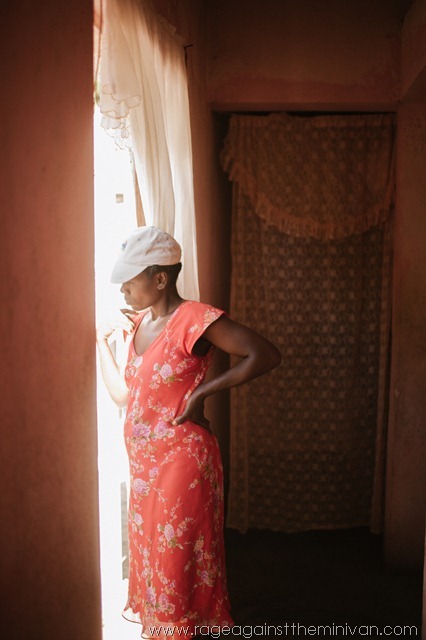 This is Fifi. She lives outside of Port-au-Prince, in the hills of Guibert. Her home crumbled after the earthquake, and she had no backup plan. For over a year, she and her family resided in a tent outside the rubble where their home once stood. Help One Now offered them a microfinance loan to build a rabbit hutch in their backyard, to buy rabbits, and to start a garden. For an American, this may seem like such basic stuff . . . but for this family it was a game-changer. They are now able to be self-sufficient, and they have a back-up plan in case weather ruins their crops.
This is Fifi. She lives outside of Port-au-Prince, in the hills of Guibert. Her home crumbled after the earthquake, and she had no backup plan. For over a year, she and her family resided in a tent outside the rubble where their home once stood. Help One Now offered them a microfinance loan to build a rabbit hutch in their backyard, to buy rabbits, and to start a garden. For an American, this may seem like such basic stuff . . . but for this family it was a game-changer. They are now able to be self-sufficient, and they have a back-up plan in case weather ruins their crops. 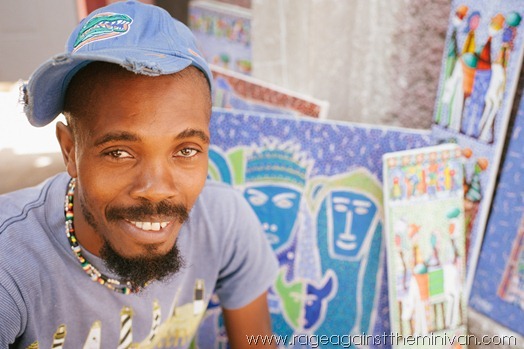 This is Richard. He is an artist who also lives in Guibert. A microfinance loan helped him buy materials he needed to sure up his art business. Since receiving his loan he was able to get his paintings into art galleries in Petionville, and even had an art sale in the U.S. He has now paid back his loan, and also volunteers teaching art at the local school.
This is Richard. He is an artist who also lives in Guibert. A microfinance loan helped him buy materials he needed to sure up his art business. Since receiving his loan he was able to get his paintings into art galleries in Petionville, and even had an art sale in the U.S. He has now paid back his loan, and also volunteers teaching art at the local school.  I’ve mentioned this before in regards to social justice: it is SO EASY to get lost in the magnitude of need . . . to get so overwhelmed that it’s paralyzing. and to throw up your hands and do nothing in response. Once again, I’ve been reminded that the key is often to just pick a place and to work that one field. You may not change the entire landscape, but your effort may drastically change the life of a few. And as Pastor St. Cyr said, “If you visit Tent City and heart is not changed, you’ve got to be a rock.”
I’ve mentioned this before in regards to social justice: it is SO EASY to get lost in the magnitude of need . . . to get so overwhelmed that it’s paralyzing. and to throw up your hands and do nothing in response. Once again, I’ve been reminded that the key is often to just pick a place and to work that one field. You may not change the entire landscape, but your effort may drastically change the life of a few. And as Pastor St. Cyr said, “If you visit Tent City and heart is not changed, you’ve got to be a rock.” 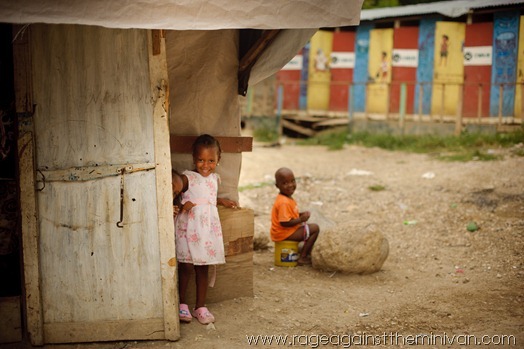 I am not a rock, and my heart was broken, again, for the people of Haiti today. I feel like I have a renewed burden, but also a renewed sense of purpose . . . and even a little excitement as I get to witness the way Help One Now is creating lasting solutions. I’m going to do my best this week not to wallow in guilt or pity, but instead to keep my heart and my eyes wide open to the ways we can best serve the Haitian people as they rebuild.
I am not a rock, and my heart was broken, again, for the people of Haiti today. I feel like I have a renewed burden, but also a renewed sense of purpose . . . and even a little excitement as I get to witness the way Help One Now is creating lasting solutions. I’m going to do my best this week not to wallow in guilt or pity, but instead to keep my heart and my eyes wide open to the ways we can best serve the Haitian people as they rebuild. 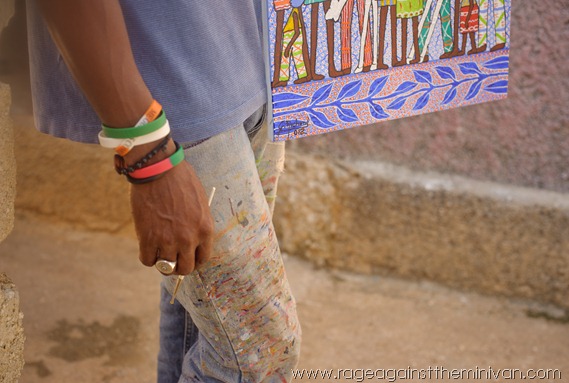 If you are interested in partnering with Help One Now with microfinance loans, you can make a one-time donation here. You can sponsor a child in tent city here. If you’re strapped for cash but still want to help, consider hosting a garage sale for orphans alongside some friends or your church.
If you are interested in partnering with Help One Now with microfinance loans, you can make a one-time donation here. You can sponsor a child in tent city here. If you’re strapped for cash but still want to help, consider hosting a garage sale for orphans alongside some friends or your church.  Photos courtesy of the talented Molly Donovan Burpo. You can follow our Twitter and Instagram feeds at #Help1Haiti.
Photos courtesy of the talented Molly Donovan Burpo. You can follow our Twitter and Instagram feeds at #Help1Haiti.

Rage Against the Minivan sometimes earns revenue through sponsored posts, which are clearly labeled, and occasional affiliate links to recommended products. I only feature products that I truly like, and my opinions are always my own.